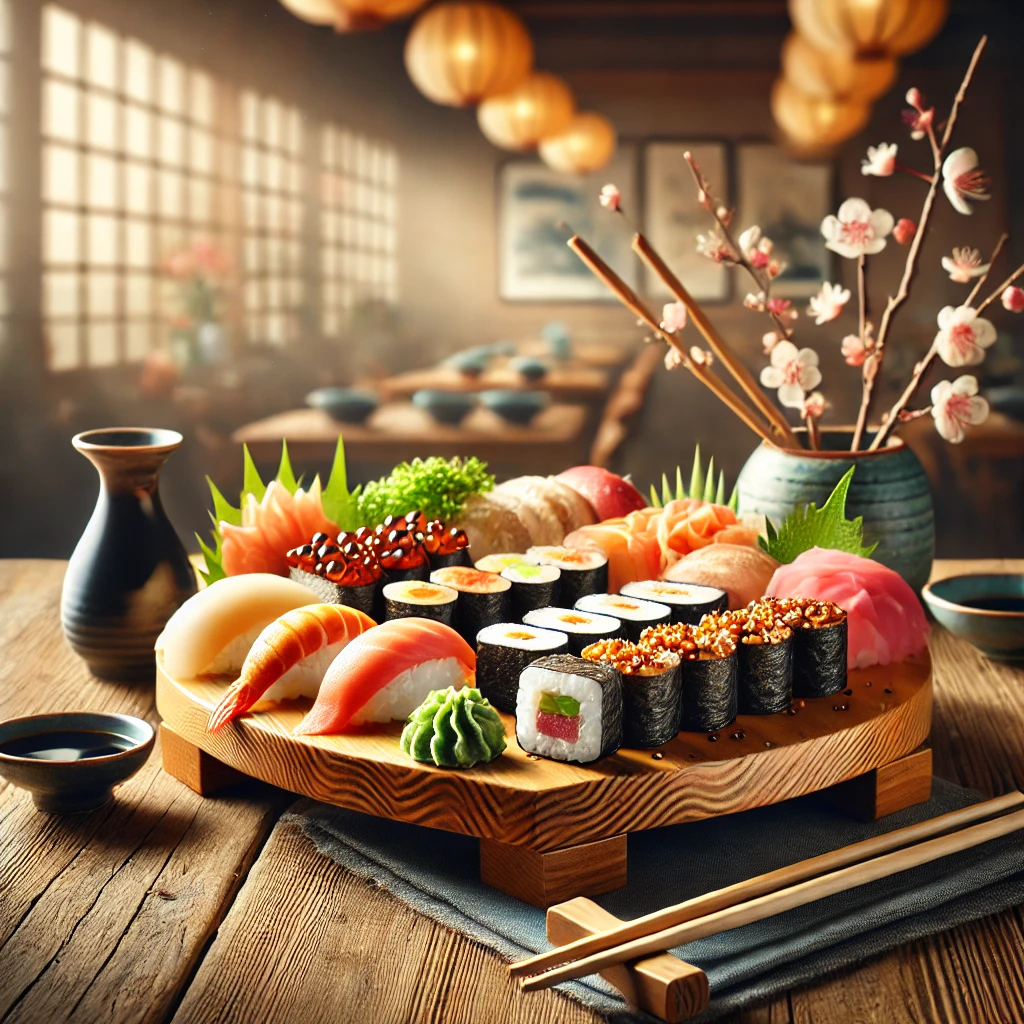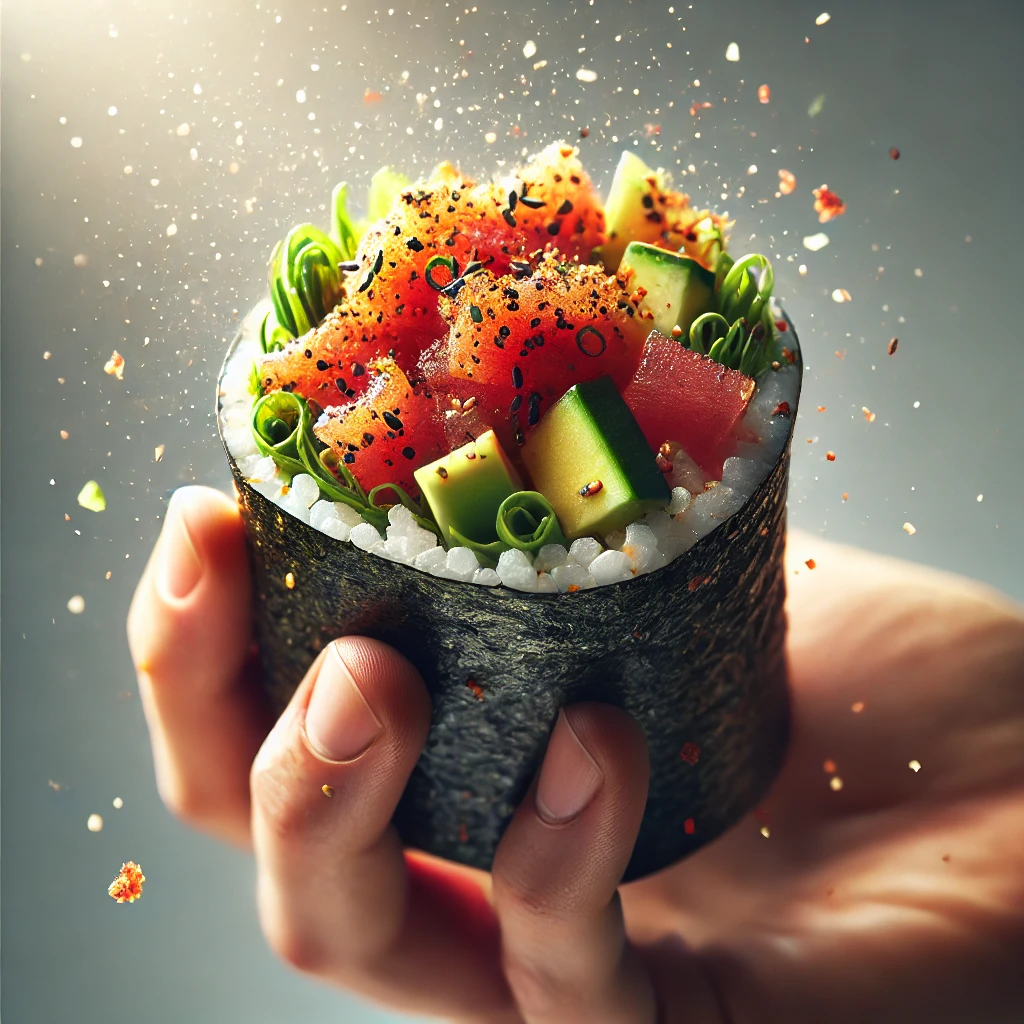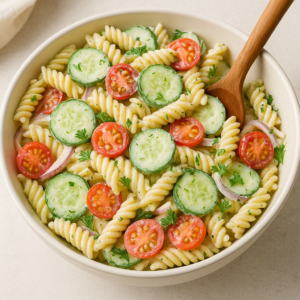This post may include affiliate links which means I may receive a commission from purchases made through links. I will only recommend products I have personally used. Learn more on my private policy page.

When you step into a Japanese restaurant, the wide array of types of sushi on the menu can be both exciting and overwhelming.
Whether you’re a seasoned sushi lover or a first-time diner, understanding the different types of sushi is key to enjoying this culinary adventure to the fullest.
In this blog post, we will guide you through the various types of sushi, helping you choose the perfect dish to suit your palate.
Introduction to Types of Sushi
Sushi is more than just a meal; it’s an art form that reflects centuries of Japanese tradition and culture.
The diversity in the types of sushi is vast, each offering unique flavors, textures, and presentation styles.
From the simplicity of Nigiri to the elaborate rolls of Maki, sushi offers something for everyone.
In this post, we’ll explore the most popular types of sushi, delving into what makes each one special and offering tips on how to order the best sushi for your taste preferences.
What Are the Different Types of Sushi?
Before exploring the various types of sushi, it’s essential to understand what sushi truly is.
Sushi is a traditional Japanese dish made with vinegared rice and paired with ingredients like seafood, vegetables, and occasionally tropical fruits.
The main components of sushi are sushi rice (shari) and fish or other toppings (neta). There are several types of sushi, each with its own unique characteristics.
1. Nigiri Sushi: The Classic Choice

Nigiri is one of the most traditional types of sushi, often considered the epitome of sushi craftsmanship.
It consists of a small mound of sushi rice topped with a slice of fish or other seafood, and sometimes a dab of wasabi is placed between the rice and the topping.
Nigiri is typically served in pairs and is meant to be eaten in one bite.
- Popular Types of Nigiri Sushi: Some popular types of Nigiri include Maguro (tuna), Sake (salmon), Ebi (shrimp), and Unagi (eel).
- Each type offers a distinct flavor and texture, allowing diners to experience the essence of the fish.
- How to Order Nigiri Sushi: When ordering Nigiri, it’s recommended to start with lighter fish and progress to richer, more flavorful options.
- This allows your palate to appreciate the subtle flavors of each fish without being overwhelmed.
2. Maki Sushi: The Rolled Delight

Maki sushi, or simply Maki, is what most people think of when they hear the word “sushi.”
Maki consists of sushi rice and various fillings, such as fish, vegetables, and sometimes fruit, all rolled up in a sheet of nori (seaweed).
It is then cut up.
- Types of Maki Sushi: There are several types of Maki, including Hosomaki (thin rolls), Futomaki (thick rolls), and Uramaki (inside-out rolls).
- Each type offers a different balance of rice and filling, catering to different taste preferences.
- Popular Maki Sushi Rolls: Some popular Maki rolls include the California Roll, Spicy Tuna Roll, and the Dragon Roll.
- These rolls often feature a combination of fish, vegetables, and sauces, creating a burst of flavors in every bite.
- How to Order Maki Sushi: Maki rolls are a great option for those new to sushi or those who enjoy a variety of flavors in one bite.
- When ordering, consider trying a mix of traditional rolls and specialty rolls to experience a range of tastes.
3. Sashimi: Pure and Simple

Sashimi is not technically a type of sushi since it does not include rice, but it’s often served alongside sushi in Japanese restaurants.
Sashimi consists of thin slices of raw fish or seafood, served without any rice.
It’s a dish that highlights the pure, unadulterated flavor of the fish.
- Popular Types of Sashimi: Common sashimi options include Maguro (tuna), Sake (salmon), Hamachi (yellowtail), and Tako (octopus).
- Each type of sashimi offers a unique texture and taste, often enhanced with a dip in soy sauce and a touch of wasabi.
- How to Order Sashimi: Sashimi is best enjoyed by those who appreciate the taste of raw fish in its purest form.
- When ordering, consider pairing sashimi with a light soy sauce or ponzu sauce to complement the flavors of the fish.
Specialty Types of Sushi: Unique Flavors and Ingredients
As sushi has grown in popularity around the world, chefs have experimented with new flavors and ingredients, leading to the creation of specialty sushi types.
These specialty sushi rolls often feature unique combinations of ingredients, sauces, and presentation styles, offering something different from the traditional types of sushi.
1. Temaki Sushi: Hand Rolls

Temaki sushi, or hand rolls, are a fun and casual type of sushi that is rolled by hand into a cone shape.
Unlike Maki, which is sliced into pieces, Temaki is designed to be eaten with your hands, making it a more interactive dining experience.
- Popular Types of Temaki Sushi: Common fillings for Temaki include tuna, salmon, avocado, and cucumber.
- Some Temaki rolls also feature tempura shrimp or spicy tuna, adding a crunchy or spicy element to the roll.
- How to Order Temaki Sushi: Temaki is perfect for those who enjoy a hands-on approach to dining.
- When ordering, consider trying a variety of fillings to experience different flavor combinations.
2. Chirashi Sushi: Scattered Sushi

Chirashi sushi, or scattered sushi, is a bowl of sushi rice topped with a variety of sashimi and other ingredients.
It’s a deconstructed version of sushi that offers a more casual and customizable dining experience.
- Popular Types of Chirashi Sushi: Chirashi bowls often include a mix of sashimi, such as tuna, salmon, and shrimp, along with vegetables like cucumber, avocado, and pickled ginger.
- Some bowls also feature tamago (sweet egg omelet) or ikura (salmon roe) for added flavor.
- How to Order Chirashi Sushi: Chirashi is a great option for those who enjoy the flavors of sushi but prefer a more relaxed dining experience.
- When ordering, feel free to customize your bowl with your favorite types of sashimi and toppings.
Understanding the Different Types of Sushi Rice
Sushi rice, also known as shari or sumeshi, is a critical component of all types of sushi.
Salt, some sugar, rice vinegar are used to as seasoning for the rice and cause it to have a slightly sweet and tangy flavor that complements the fish and other toppings.
The texture and flavor of the rice can vary depending on the type of sushi being made.
1. Short-Grain Rice: The Foundation of Sushi
Its sticky texture makes it ideal for forming sushi rolls, nigiri, and other types of sushi.
The rice grains are small and plump, which allows them to hold together well when pressed or rolled.
- How to Prepare Sushi Rice: To prepare sushi rice, the rice is first rinsed to remove excess starch, then cooked until tender.
- Once ready, seasoning is added ( salt, sugar and some rice vinegar) then cooled to room temperature before being used in sushi.
2. Brown Rice Sushi: A Healthier Alternative
In recent years, brown rice sushi has become popular as a healthier alternative to traditional white sushi rice.
Brown rice is less processed and retains more of its natural nutrients, including fiber and vitamins.
- Types of Sushi with Brown Rice: Brown rice can be used in most types of sushi, including Nigiri, Maki, and Temaki.
- The slightly nutty flavor and chewier texture of brown rice offer a different taste experience compared to white rice.
- How to Order Brown Rice Sushi: If you’re looking for a healthier option, consider ordering your sushi with brown rice.
- Keep in mind that the flavor and texture will be different from traditional sushi rice, but it can be a delicious alternative.
Exploring Regional Types of Sushi
Japan is home to a rich diversity of sushi styles, many of which are unique to specific regions.
Each region has its own approach to sushi, influenced by local ingredients, culture, and history.
Here are some regional types of sushi that you might encounter at a Japanese restaurant.
1. Edomae Sushi: The Tokyo Style

Edomae sushi, also known as Edo-style sushi, originated in Tokyo (formerly known as Edo) during the Edo period.
This style of sushi emphasizes simplicity and freshness, with a focus on high-quality fish and minimal seasoning.
- Types of Edomae Sushi: Edomae sushi typically includes Nigiri made with fresh, seasonal fish.
- Some Edomae sushi also features fish that has been marinated or cured to enhance its flavor.
- How to Order Edomae Sushi: When ordering Edomae sushi, look for dishes that feature fresh, seasonal ingredients.
- This style of sushi is best enjoyed when the fish is at its peak freshness.
2. Kansai Sushi: The Osaka Style
Kansai sushi, or Osaka-style sushi, is known for its use of pressed sushi, also known as Oshizushi.
In this style, sushi rice and toppings are pressed into a rectangular mold, then sliced into bite-sized pieces.
- Types of Kansai Sushi: Popular types of Kansai sushi include Hakozushi (box sushi) and Battera (pressed mackerel sushi).
- These sushi types often feature a combination of fish, vegetables, and rice, all tightly pressed together.
- How to Order Kansai Sushi: Kansai sushi offers a unique texture and flavor experience compared to more traditional types of sushi.
- When ordering, consider trying Oshizushi or Battera to experience the distinctive taste of Osaka-style sushi.
3. Hokkaido Sushi: The Northern Style
Hokkaido, Japan’s northernmost island, is known for its rich seafood, and this is reflected in its sushi.
Hokkaido sushi often features fresh seafood caught in the cold waters surrounding the island.
- Types of Hokkaido Sushi: Some popular types of Hokkaido sushi include Uni (sea urchin), Ikura (salmon roe), and Hotate (scallop).
- These sushi types are known for their rich, creamy flavors and are often considered delicacies.
- How to Order Hokkaido Sushi: If you have the opportunity to try Hokkaido sushi, don’t miss out on the chance to enjoy some of the freshest and most flavorful seafood available.
- These sushi types are often served with minimal seasoning to allow the natural flavors to shine.
Vegetarian and Vegan Types of Sushi

While sushi is traditionally made with fish, there are plenty of options for vegetarians and vegans to enjoy as well.
Many Japanese restaurants offer vegetarian and vegan sushi that features fresh vegetables, tofu, and other plant-based ingredients.
1. Vegetable Maki: A Simple and Delicious Choice
Vegetable Maki is a type of sushi roll that features a variety of fresh vegetables wrapped in sushi rice and nori.
Common fillings include cucumber, avocado, carrot, and asparagus.
- Popular Vegetable Maki Rolls: Some popular vegetable Maki rolls include the Avocado Roll, Cucumber Roll, and Sweet Potato Roll.
- These rolls are light, refreshing, and perfect for those who prefer a plant-based diet.
- How to Order Vegetable Maki: When ordering vegetable Maki, consider trying a variety of rolls to experience different combinations of flavors and textures.
- Many restaurants also offer specialty rolls that feature unique vegetable fillings and sauces.
2. Inari Sushi: A Sweet and Savory Delight
Inari sushi is a style of sushi where rice is packed into a pouch of seasoned tofu.
The tofu is typically marinated in a sweet and savory sauce, giving it a rich flavor that pairs well with the sushi rice.
- Types of Inari Sushi: Inari sushi is often served plain, but some variations include additional fillings such as vegetables or sesame seeds.
- It’s a popular option for vegetarians and vegans due to its simplicity and delicious flavor.
- How to Order Inari Sushi: Inari sushi is a great option for those who enjoy a sweet and savory combination.
- It’s typically served as a small, bite-sized portion, making it a perfect addition to a sushi platter.
Sushi Etiquette: How to Enjoy Different Types of Sushi

Understanding sushi etiquette can enhance your dining experience and help you enjoy the different types of sushi to the fullest.
Here are some tips on how to properly eat and appreciate sushi in a Japanese restaurant.
1. Using Chopsticks vs. Hands
While chopsticks are commonly used to eat sushi, it’s perfectly acceptable to eat certain types of sushi, such as Nigiri and Temaki, with your hands.
The key is to handle the sushi gently to avoid crushing the rice or fish.
- Chopstick Etiquette: When using chopsticks, avoid rubbing them together after breaking them apart, as this can be seen as rude.
- Additionally, never point your chopsticks at someone or pass food directly from one pair of chopsticks to another.
2. Dipping Sushi in Soy Sauce
When dipping sushi in soy sauce, it’s important to do so lightly to avoid overpowering the delicate flavors of the fish.
For Nigiri sushi, dip the fish side, not the rice, into the soy sauce to prevent the rice from absorbing too much sauce and falling apart.
- Using Wasabi and Ginger: Wasabi can be added directly to the sushi or mixed into the soy sauce, depending on your preference.
- Pickled ginger is often served as a palate cleanser between different types of sushi, so it’s best enjoyed in between bites rather than on top of the sushi.
3. Eating Sushi in the Right Order
To fully appreciate the flavors of different types of sushi, it’s recommended to eat them in a specific order.
Start with lighter, milder fish and progress to richer, more flavorful options.
This allows your palate to adjust and enjoy the nuances of each type of sushi.
- Respecting the Chef: In traditional sushi restaurants, the sushi chef is highly respected for their skill and craftsmanship.
- It’s customary to show appreciation for the chef’s work by eating the sushi in the order it is presented and avoiding unnecessary alterations or additions to the dish.
Conclusion: Discovering Your Favorite Types of Sushi
The world of sushi is incredibly diverse, with countless types of sushi to explore and enjoy.
Whether you prefer the simplicity of Nigiri, the variety of Maki rolls, or the purity of Sashimi, there’s something for every palate at a Japanese restaurant.
By understanding the different types of sushi and how to order them, you can enhance your dining experience and discover new flavors that you’ll love.
As you continue to explore the different types of sushi, don’t be afraid to try something new or ask the sushi chef for recommendations.
With so many options available, there’s always something new to discover and enjoy in the world of sushi.
Whether you’re a seasoned sushi enthusiast or a newcomer to Japanese cuisine, the journey of exploring sushi is one that is sure to delight your taste buds and expand your culinary horizons.
In the end, the best type of sushi is the one that brings you the most joy.
So next time you visit a Japanese restaurant, use this guide to help you navigate the menu and find the perfect sushi for your palate.
Enjoy the experience, savor the flavors, and remember that the world of sushi is vast, with endless possibilities to explore.




